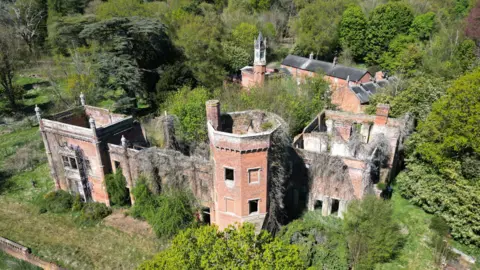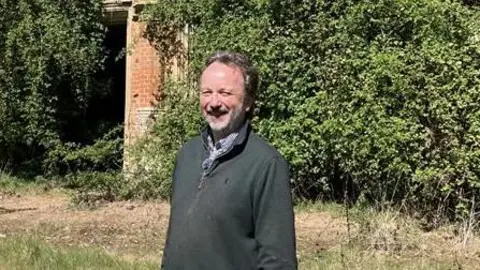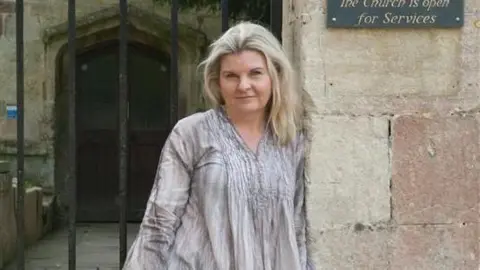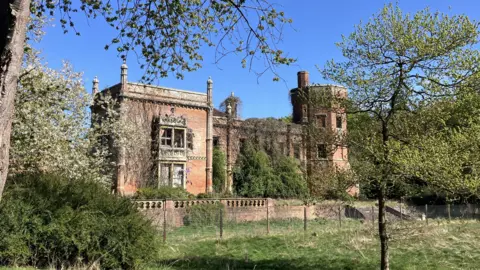Crumbling ruins hold the secrets of centuries past
 Stuart Howells/BBC
Stuart Howells/BBCNestled in the depths of Suffolk lies Rougham Hall – a ruined manor with a deep and rich history spanning hundreds of years.
The hall is found on Rougham Estate near Bury St Edmunds, but it is off limits to members of the public and can be visited only during guided tours.
During its history it has been the scene of huge parties spanning several days, and it was bombed during World War Two.
George Agnew, whose family has owned the estate since 1904, said the crumbling walls added to the allure of the site.
Mr Agnew's father demolished part of the building several decades ago for safety reasons and almost had the rest of it brought down.
"I was away doing some studying abroad and I came back and he was about to have the rest of it demolished," Mr Agnew explained.
"There was a site meeting up here with a demolition people and my brother and I insisted that it wasn't pulled down, which is why it's here now.
"But in the back of my head there's this voice the whole time of my father saying, 'I hope you haven't made a mistake here'."
 Matt Marvel/BBC
Matt Marvel/BBCIf the hall's deteriorating walls could talk, they would share incredible tales of times gone by.
In 1940 the hall was bombed by the German Luftwaffe, the reasons for which are still not really known.
The bomber initially flew around the house dropping flares before the first bomb fell straight through the middle of the house and exploded.
No-one was injured, but Mr Agnew theorised the Germans had perhaps confused the house with another owned by the Rothschild family nearby.
"In a sort of way it saved the history of this building," he said.
"I feel it's almost like the shock that saved the building."
Mr Agnew said the hall was still "very impressive" and he was keen to preserve it in its current state.
He said minimising the number of people visiting it would help.
"It's not to stop people enjoying it, it's that the building is very delicate and we get a lot of people coming here who shouldn't be," he said.
"I'm trying to get the message through to keep everybody safe while enjoying and preserving it for the future."
 Contributed
ContributedJane Bennet-Earle is a descendant of the family that owned Rougham Hall years before Mr Agnew's family.
In the late 1700s, Roger Kedington was the owner of the estate and had one legitimate child, a daughter called Jane Judith.
When he died in 1818, the estate passed to his daughter's husband – Philip Bennet, who was originally from the Bath area.
The hall passed down generations of her family before it was sold in 1893 for £80,000 – the equivalent of about £9m in today's money – to the owner of the London Evening Standard, and later it was sold to Mr Agnew's family.
Mrs Bennet-Earle is passionate about her family's history and, despite living in Australia, she regularly visits.
"The icing on the cake last visit was George taking us to where the Bennet graves are in the churchyard," she said.
"I couldn't find them... they were completely covered. You wouldn't even know there was a grave there.
"I had wanted to find those for 20 years. I found them and there was Party Boy."
Party Boy was another Philip Bennet, born in 1837 at Rougham Hall who held a three-day party for his 21st birthday.
Mrs Bennet-Earle said no expenses were spared, with hundreds of guests invited, and a song was written at the time about it.
 Matt Marvel/BBC
Matt Marvel/BBCLike Mr Agnew, Mrs Bennet-Earle does not see any point in restoring the hall and she believes its current state is what captures people's interest.
"From the state it's in, to restore that I think would be very, very expensive," she said.
"It's beautiful as it is, it attracts people as it is, and it's quite unique. I think it adds to its beauty.
"To leave it as it is is fine by me."
Follow Suffolk news on BBC Sounds, Facebook, Instagram and X.
